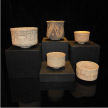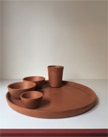Pottery has been the basic manufacture in Indus Valley cities. While some wares are
handcrafted, most are wheel-turned. Shapes are basic but the variety of utensils is
expansive, ranging from pots and pans to beakers, pointed-base goblets and handled
cups. Geometric designs are prevalent with naturalistic patterns, intersecting circles,
checks and foliage being other favourites.
The red exterior is decorated with black and some bear a short stamped inscription.
Five thousand years on, these terracotta utensils will be the only humble survivors,
aiding historians to resurrect this civilization.
In times to come, metals will see unprecedented popularity for many centuries. Metal,
in turn, will lose following with the age of mass-production. But by the 21st century,
transition will come a full circle and terracotta will be resurrected as an eco-friendly
and low-cost material for sustainable living.
 |
Bowls from Indus Valley Civilization Designer: Unknown Year: c. 3000 - 2000 BC |
| Urban Nostalgia Tableware Designer: Design Temple Year: 2012-2013 Urban Nostalgia seeks inspiration from the traditional Indian kitchen and reinvents its staple objects in a more global context. The tableware dialogues with older material practices, popular Indian forms, and foreign cultural influences. For instance: The Urban Nostalgia thali plays on the popular compartment thali, while taking inspiration from Japanese bento boxes such that the half and quarter plates can be used in different ways. |
|
 |
Thali Dinner Set and Bottle Designer: Mitticool Year: c. 2013 Mitticool adapts the metal thali dinner set to clay forms. These products are manufactured from moulds that can yield up to 10,000 pieces in a single lifecycle. At a time when pottery is either relegated to rural kitchens, or fashioned by ceramic artists for a niche audience, Mitticool has transformed the market - providing standardised design at democratic prices. |



